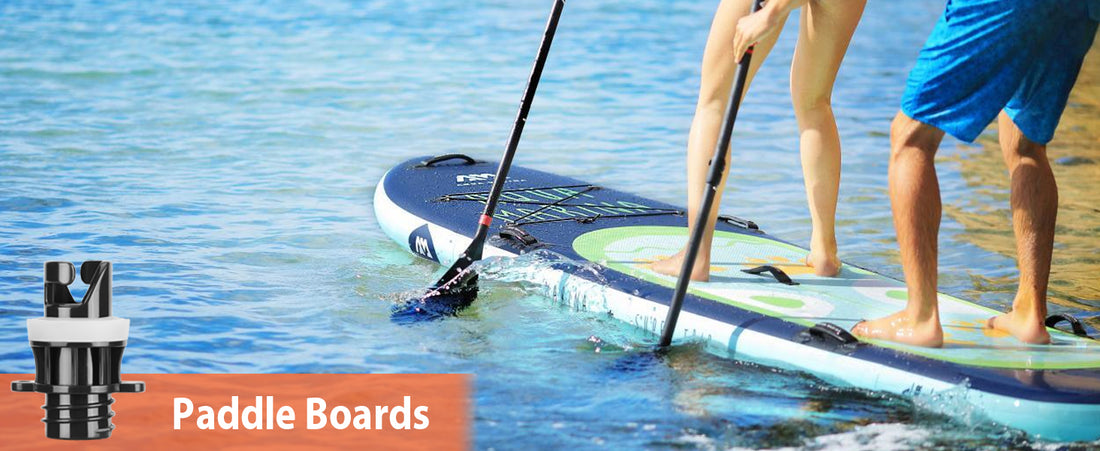
How to Choose a Pump for Inflating a Stand-Up Paddleboard (SUP)
Share
Stand-up paddleboarding (SUP) is a popular water sport that offers both adventure and relaxation. To enjoy your time on the water, it's crucial to have the right equipment, including a reliable pump to inflate your paddleboard. The right pump can make the process of preparing your board quick and easy, allowing you to spend more time paddling and less time setting up. This article will guide you through the various factors to consider when choosing a pump for your SUP, ensuring you make an informed decision.
Types of SUP Pumps
Manual pumps are a common choice for inflating SUPs, often included with the board itself. They are divided into two main categories:
1. Hand Pumps
- Double-Action Pumps: These pumps inflate your board on both the upstroke and downstroke, making the process faster and more efficient. They are portable and do not require any external power source, making them ideal for remote locations.
- Single-Action Pumps: These inflate only on the downstroke. They require more effort and time compared to double-action pumps but are generally simpler and more durable.
2. Foot Pumps
Less common for SUPs, foot pumps are operated by stepping on a pedal. They can be easier on the arms but are often slower and less efficient than hand pumps.
3. Electric Pumps
Electric pumps are powered by either batteries or a car outlet, offering a convenient and effortless way to inflate your SUP. They are particularly useful for those who find manual pumping strenuous or who need to inflate multiple boards. Electric pumps are available in two main types:
- Rechargeable Electric Pumps: These pumps come with built-in batteries that can be recharged via a wall outlet or USB. They are portable and easy to use but require regular recharging.
- 12V Car Electric Pumps: These pumps are designed to be plugged into your vehicle’s cigarette lighter or a 12V outlet. They provide consistent power and are reliable for on-site inflation, provided you have your car nearby.
Key Factors to Consider
Ease of Use
- Manual Pumps: Look for double-action hand pumps with ergonomic handles and sturdy bases. These features make pumping easier and more comfortable. Some manual pumps also come with integrated pressure gauges, which can help you monitor the pressure as you inflate.
- Electric Pumps: Choose a pump with intuitive controls, clear instructions, and an automatic shutoff feature to prevent overinflation. Digital pressure displays can be very useful for ensuring you reach the correct PSI.

Inflation Speed
- Manual Pumps: The capacity of the pump, usually measured in liters per stroke, determines how quickly it can inflate your board. Higher capacity pumps can significantly reduce the time and effort required.
- Electric Pumps: Look for a high flow rate, measured in liters per minute (L/min). A higher flow rate means faster inflation, which is crucial when you need to get on the water quickly.
Maximum Pressure
Most inflatable SUPs require inflation to a specific PSI (pounds per square inch), typically between 12 and 20 PSI. Ensuring your pump can reach this pressure is vital.
- Manual Pumps: Ensure the pump can reach the required PSI without excessive effort. Some high-quality manual pumps can reach up to 25 PSI, which is more than enough for most SUPs.
- Electric Pumps: Verify that the pump can achieve the necessary PSI. Many electric pumps have adjustable pressure settings and automatic shutoff features that stop the pump once the desired pressure is reached.
Portability and Weight
Given the nature of SUP, having a lightweight and portable pump is essential:
- Manual Pumps: These are generally lighter and more compact, making them easy to carry in your SUP bag. Some models are designed to be particularly travel-friendly, with detachable parts and compact designs.
- Electric Pumps: While these can be heavier, look for models with built-in handles and compact storage options. Some electric pumps come with carrying cases for added convenience.
Durability and Build Quality
Your pump should be durable enough to withstand regular use and the outdoor elements:
- Manual Pumps: Opt for pumps made from robust materials like aluminum or high-quality plastic. Look for features like reinforced hoses and sturdy construction to ensure longevity.
- Electric Pumps: Choose pumps with robust casings and high-quality components. Ensure that the hoses and connectors are made from durable, flexible materials that can handle repeated use.
Additional Features
- Pressure Gauge: An integrated pressure gauge is essential for monitoring the inflation level. Some pumps have built-in gauges, while others may require an external one.
- Adapters: Ensure the pump includes the necessary valve adapters for your paddleboard. Most SUPs use the Halkey-Roberts (H3) valve, so compatibility is key.
- Deflation Function: Some pumps offer a deflation mode, making it easier to pack up your board after use.
- Noise Level: Electric pumps can be noisy. If you’re inflating your board in a quiet area or early in the morning, a quieter pump might be preferable.
Choosing the right pump for inflating your stand-up paddleboard can significantly enhance your paddleboarding experience. Consider factors like ease of use, inflation speed, maximum pressure, portability, durability, and additional features when selecting a pump. Whether you prefer the manual effort of a hand pump or the convenience of an electric pump, ensuring your pump meets the needs of your specific paddleboard and usage habits is crucial. Investing in a high-quality pump will save you time and effort, allowing you to focus more on enjoying your time on the water.
